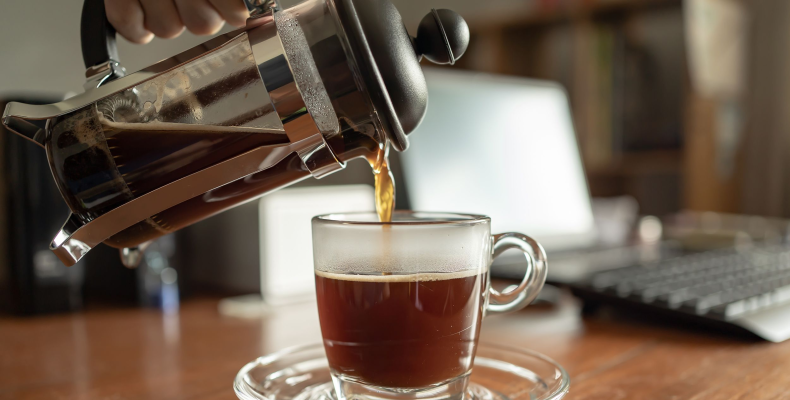Introduction:
There's something magical about starting your day with a perfectly brewed cup of coffee. The aroma, the warmth, and the rich flavors can set the tone for a great day ahead. If you're new to brewing coffee at home or looking to enhance your skills, this beginner's guide is here to help. In this article, we'll explore the art of brewing coffee, covering essential techniques and tips to help you master the art of brewing and create exceptional coffee right in your own kitchen.
- Start with Quality Beans:
The foundation of a great cup of coffee is high-quality beans. Seek out specialty coffee shops or reputable online suppliers that offer freshly roasted beans. Look for beans with roast dates to ensure freshness. Experiment with different origins and roasts to discover your preferences. Whole beans provide the best flavor, so invest in a grinder to grind your beans just before brewing.
- Understand Brewing Methods:
There are various brewing methods to explore, each offering a unique flavor profile and brewing experience. Some popular methods include pour-over, French press, Aeropress, and espresso. Research and try different methods to find the one that suits your taste preferences and lifestyle. Each method has its own nuances and requires specific equipment and techniques. Understanding the basics of each method will empower you to brew coffee that suits your desired strength, flavor, and brewing time.
- Perfecting the Pour-Over Technique:
Pour-over brewing is a favorite among coffee enthusiasts due to its simplicity and control over extraction. To achieve a great pour-over brew, start by heating water to the ideal temperature (around 200°F). Place a filter in a dripper or pour-over device, add ground coffee, and slowly pour hot water in a circular motion over the coffee bed. The key is to maintain a steady pour rate and achieve an even extraction. Experiment with different grind sizes and water-to-coffee ratios to find the balance that suits your taste.
- Mastering the French Press:
The French press method offers a full-bodied and robust cup of coffee. Start by adding coarsely ground coffee to the press, then pour hot water (around 200°F) over the grounds. Allow the coffee to steep for about four minutes, then slowly press down the plunger. This separates the brewed coffee from the grounds, resulting in a rich and flavorful brew. Adjust the steeping time and coffee-to-water ratio to tailor the strength of your coffee to your preference.
- Embracing the Aeropress:
The Aeropress is a versatile and compact brewing device that produces a clean and smooth cup of coffee. Begin by placing a filter in the Aeropress and setting it on a cup or mug. Add medium-fine ground coffee and pour hot water (around 175-185°F) over the coffee, stirring gently. After a short steeping time, press the coffee through the filter using the plunger. The Aeropress allows for experimentation with different brewing techniques and recipes, such as the inverted method or using varying water temperatures.
- Exploring the World of Espresso:
Espresso brewing is an art in itself, requiring a dedicated espresso machine or a manual espresso maker like a Moka pot. Start by selecting a finely ground coffee specifically labeled for espresso. Preheat the machine and the cup, then add the ground coffee into the portafilter and distribute it evenly. Tamp the coffee with consistent pressure, attach the portafilter to the machine, and start the extraction. Proper extraction time, temperature, and pressure are crucial for a well-balanced espresso shot. The ideal extraction time is typically between 25 to 30 seconds, resulting in a small amount of concentrated, rich coffee. Experiment with grind size, dose, and extraction time to find the perfect balance and create your desired espresso shot. Remember, mastering espresso brewing takes practice and patience, but once you've perfected the technique, you'll be able to enjoy a variety of espresso-based drinks like cappuccinos, lattes, and macchiatos right at home.
- Pay Attention to Water Quality:
Water quality plays a significant role in the taste of your coffee. Avoid using tap water with strong odors or high mineral content, as it can negatively affect the flavor. Filtered or bottled water is a better option to ensure a clean and pure taste. Experiment with different water sources to find the one that enhances the flavors of your coffee beans and brings out their best characteristics.
- Experiment with Ratios and Brewing Variables:
The beauty of brewing coffee at home is the ability to tailor each cup to your preferences. Don't be afraid to experiment with different brewing variables like coffee-to-water ratios, grind sizes, brewing times, and temperatures. Small adjustments can have a big impact on the final cup. Keep a brewing journal to note your experiments and the results, helping you refine your brewing process over time.
- Practice Consistency:
Consistency is key to achieving great results with your home brewing. Once you find the brewing method, ratio, and variables that suit your taste, strive to replicate it consistently. Use a kitchen scale to measure your coffee and water accurately, and time your brewing process to maintain consistency. This ensures that you can enjoy your favorite cup of coffee consistently, day after day.
- Savor the Experience:
Brewing coffee at home is not just about the end result; it's also about the process itself. Take the time to savor each step, from the aroma of freshly ground beans to the sound of water pouring over the coffee grounds. Engage your senses and embrace the ritual of brewing. The more you immerse yourself in the experience, the more rewarding and enjoyable it becomes.
Conclusion:
Brewing coffee at home is a delightful journey that allows you to craft the perfect cup to suit your taste and preferences. Whether you choose the pour-over method, French press, Aeropress, or espresso brewing, understanding the techniques and variables involved will empower you to create exceptional coffee right in your own kitchen. Remember to start with high-quality beans, experiment with different brewing methods and variables, and embrace the joy of the brewing process. With practice, patience, and a spirit of exploration, you'll soon become a skilled home barista, able to enjoy the perfect cup of coffee whenever you desire.

